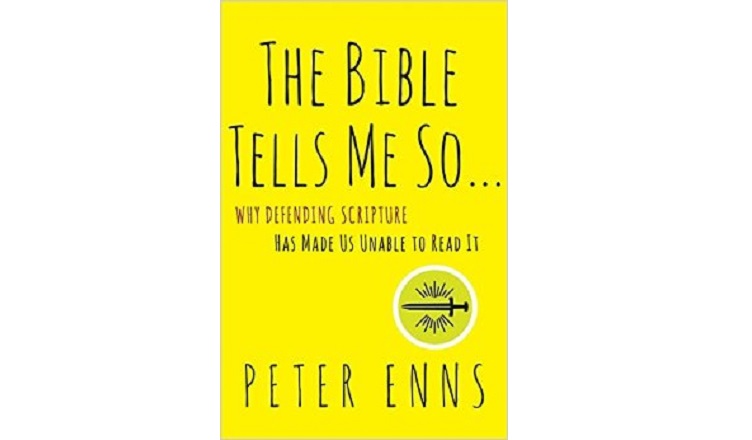 Pete has written a very readable book which attempts to help people struggling with how to read and interpret the bible in light of today’s debates about the bible, its interpretation and history.
Pete has written a very readable book which attempts to help people struggling with how to read and interpret the bible in light of today’s debates about the bible, its interpretation and history.
- Link: Amazon
- Length: 243
- Difficulty: Easy-Popular
- Topic: Hermeneutics
- Audience: Mainstream Christians
I like Pete, he has a good sense of humour and is a sincere Christian. It’s also clear he interacts with the most recent old testament scholarship, archaeological evidence and is attempting to create a fusion with a robust biblical faith.
He has also identified himself as a ‘troublemaker’ (p139). This book combines all these above elements into one.
Contents
- Chapter 1— I’ll Take Door Number Three
- Chapter 2— God Did What?!
- Chapter 3— God Likes Stories
- Chapter 4— Why Doesn’t God Make Up His Mind?
- Chapter 5— Jesus Is Bigger Than the Bible
- Chapter 6— No One Saw This Coming
- Chapter 7— The Bible, Just as It Is
Main points
In chapter one, Pete introduces his book describing a predicament some are in about biblical interpretation. The rules of interpretation forced on the bible make it impossible to be read faithfully and correctly. The primary rule he takes aim at is the assumption the bible’s narratives and in particular some Old Testament narratives reflect historical fact. He gives his own testimony and rationale for how he came to where he is now.
I live in Australia. I’m an Australian. In don’t live in the American evangelical context that may well be continually engaged in debates over creation, evolution, inerrancy and old testament interpretation. I may well be ignorant, but I didn’t think this was as much a problem as Pete suggests.
I’m sure Pete could have chosen a number of topics to make his point. In chapter two he considers Israel’s invasion of the promised land and common justifications for it. He argues the authors of these accounts did not write them to communicate historical fact. He demonstrates the narratives were written a long time ago with certain aims in mind different from what some assume today. The scriptural accounts stem from the immature faith and worldview of its authors. A tribal worldview set in the context where different cultures had different gods in competition.
In chapters three and four Pete addresses a variety of issues on the same theme of historical accuracy and author’s intent. He considers a variety of topics including:
- the varying gospel accounts,
- the different stories of Israel in 1 and 2 Kings and Chronicles,
- the Genesis story with Adam and Eve in the garden,
- the exodus from Egypt,
- various scriptures which suggest more god’s exist than the God of Israel.
- depictions of God which make him look like a regular person, and
- the evolving law of Moses.
I stand in agreement with Pete’s argument the scriptures were written from an ancient world-view with certain aims in mind. However, his arguments could lead some to think there is no historical truth behind Israel’s story whatsoever. NT Wright proposes a theory for discovering history behind coloured perspectives in New Testament and the People of God (p88-109, Wright, N.T., 1992. The New Testament and the People of God, London: Society for Promoting Christian Knowledge). I feel Pete should have made similar comments as well. But he didn’t. I suspect his reading list at the end of the book might address these issues.
One well known rule of biblical interpretation is called the analogy of faith. Basically when two biblical texts seem to contradict, the reader should interpret them both in such a way that they agree. Sometimes I felt Pete seemed to give no effort to harmonising the texts he considers, opting for contradiction instead. But, we all tend to interpret the same bible differently anyhow.
Chapters five and six I enjoyed most. Pete looks at Jesus and the way he creatively interpreted the old testament scriptures. He argues Jesus is adopting the regular style of Jewish interpretation in the first century. Pete does this to contrast Jesus’ method of interpretation with the way many today believe the bible should be interpreted. He argues if Jesus attended bible college (seminary) he would get a Fail grade.
Like Jesus, the apostles interpret the old testament in different ways than we do today. They interpret all scripture in the light of Jesus. They argue all scripture points to him and sometimes rip the OT texts out of context to do so.
Pete then discusses Paul. Paul believed Jesus drew all nations to himself and this was prophesied in the OT and in the law of Moses. Pete is quite sympathetic to the New Perspective on Paul.
In the last chapter, chapter seven, Pete gives a concluding summary of the book. He also gives some comments and directions about how the bible reflects the maturing faith of the people of God and encourages his readers in the same walk of faith. Lastly he gives a reading list for further reading.
Recommendation
The book gives a good and readable overview of the problems associated with naive uneducated biblical interpretation.
I’d recommend the book to people struggling with various issues on the historical nature of the bible. If they read this book it would give them a helpful direction to go in support a robust faith. I’d also recommend they read further from his reading list.
But for those who are not struggling with the bible as he fears. I would only recommend it if they want to learn more. The book may open up a can of worms for some, and for that reason I would caution people before reading it.
Copyright © Joshua Washington and thescripturesays, 2015. All Rights Reserved.





